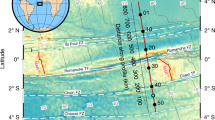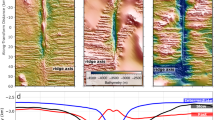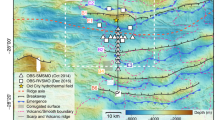Abstract
Oceanic transform faults are seismically and tectonically active plate boundaries1 that leave scars—known as fracture zones—on oceanic plates that can cross entire ocean basins2. Current descriptions of plate tectonics assume transform faults to be conservative two-dimensional strike–slip boundaries1,3, at which lithosphere is neither created nor destroyed and along which the lithosphere cools and deepens as a function of the age of the plate4. However, a recent compilation of high-resolution multibeam bathymetric data from 41 oceanic transform faults and their associated fracture zones that covers all possible spreading rates shows that this assumption is incorrect. Here we show that the seafloor along transform faults is systemically deeper (by up to 1.6 kilometres) than their associated fracture zones, in contrast to expectations based on plate-cooling arguments. Accretion at intersections between oceanic ridges and transform faults seems to be strongly asymmetric: the outside corners of the intersections show shallower relief and more extensive magmatism, whereas the inside corners have deep nodal basins and seem to be magmatically starved. Three-dimensional viscoplastic numerical models show that plastic-shear failure within the deformation zone around the transform fault results in the plate boundary experiencing increasingly oblique shear at increasing depths below the seafloor. This results in extension around the inside corner, which thins the crust and lithosphere at the transform fault and is linked to deepening of the seafloor along the transform fault. Bathymetric data suggest that the thinned transform-fault crust is augmented by a second stage of magmatism as the transform fault intersects the opposing ridge axis. This makes accretion at transform-fault systems a two-stage process, fundamentally different from accretion elsewhere along mid-ocean ridges.
This is a preview of subscription content, access via your institution
Access options
Access Nature and 54 other Nature Portfolio journals
Get Nature+, our best-value online-access subscription
$29.99 / 30 days
cancel any time
Subscribe to this journal
Receive 51 print issues and online access
$199.00 per year
only $3.90 per issue
Buy this article
- Purchase on Springer Link
- Instant access to full article PDF
Prices may be subject to local taxes which are calculated during checkout




Similar content being viewed by others
Data availability
Data are freely available at https://maps.ngdc.noaa.gov/viewers/bathymetry, http://www.godac.jamstec.go.jp/darwin/e and https://www.bsh.de/EN. Bathymetric grids compiled from these sources are shown in Supplementary Information and are available at https://doi.pangaea.de/10.1594/PANGAEA.924451. Additional gridded bathymetric data of transform faults are from Romanche49, Chain50 and 5° S51 in the Atlantic Ocean, Guamblin in the Pacific Ocean off Chile52 and Prince Edward in the Indian Ocean53. The geodynamic simulations were computed using the community code ASPECT, version 2.1.0 (https://aspect.geodynamics.org). Source data are provided with this paper.
References
Wilson, J. T. A new class of faults and their bearing on continental drift. Nature 207, 343–347 (1965).
Menard, H. W. Extension of northeastern-Pacific fracture zones. Science 155, 72–74 (1967).
Sykes, L. R. Mechanism of earthquakes and nature of faulting on the mid‐oceanic ridges. J. Geophys. Res. 72, 2131–2153 (1967).
Sandwell, D. T. Thermomechanical evolution of oceanic fracture zones. J. Geophys. Res. 89, 11401–11413 (1984).
Sandwell, D. T., Müller, R. D., Smith, W. H. F., Garcia, E. & Francis, R. New global marine gravity model from CryoSat-2 and Jason-1 reveals buried tectonic structure. Science 346, 65–67 (2014).
Bird, P. An updated digital model of plate boundaries. Geochem. Geophys. Geosyst. 4, 1027 (2003).
Morgan, J. P. & Parmentier, E. M. Lithospheric stress near a ridge‐transform intersection. Geophys. Res. Lett. 11, 113–116 (1984).
Fox, P. J. & Gallo, D. G. A tectonic model for ridge transform ridge plate boundaries - implications for the structure of oceanic lithosphere. Tectonophysics 104, 205–242 (1984).
Fornari, D. J. et al. Structure and topography of the Siqueiros transform fault system: evidence for the development of intra-transform spreading centers. Mar. Geophys. Res. 11, 263–299 (1989).
Gregg, P. M., Lin, J., Behn, M. D. & Montesi, L. G. J. Spreading rate dependence of gravity anomalies along oceanic transform faults. Nature 448, 183–187 (2007).
Searle, R. C., Thomas, M. V. & Jones, E. J. W. Morphology and tectonics of the Romanche transform and its environs. Mar. Geophys. Res. 16, 427–453 (1994).
Karson, J. A. & Dick, H. J. B. Tectonics of ridge-transform intersections at the Kane fracture zone. Mar. Geophys. Res. 6, 51–98 (1983).
Gallo, D. G., Fox, P. J. & Macdonald, K. C. A Seabeam investigation of the Clipperton transform fault: the morphotectonic expression of a east slipping transform boundary. J. Geophys. Res. 91, 3455–3467 (1986).
Barth, G. A., Kastens, K. A. & Klein, E. M. The origin of bathymetric highs at ridge-transform intersections: a multi-disciplinary case study at the Clipperton fracture zone. Mar. Geophys. Res. 16, 1–50 (1994).
Davis, E. E. & Lister, C. R. B. Fundamentals of ridge crest topography. Earth Planet. Sci. Lett. 21, 405–413 (1974).
Behn, M. D., Boettcher, M. S. & Hirth, G. Thermal structure of oceanic transform faults. Geology 35, 307–310 (2007).
McKenzie, D. Finite deformation during fluid flow. Geophys. J. R. Astron. Soc. 58, 689–715 (1979).
Roland, E., Behn, M. D. & Hirth, G. Thermal‐mechanical behavior of oceanic transform faults: implications for the spatial distribution of seismicity. Geochem. Geophys. Geosyst. 11, Q07001 (2010).
Rüpke, L. H. & Hasenclever, J. Global rates of mantle serpentinization and H2 production at oceanic transform faults in 3-D geodynamic models. Geophys. Res. Lett. 44, 6726–6734 (2017).
McGuire, J. et al. Variations in earthquake rupture properties along the Gofar transform fault, East Pacific Rise. Nat. Geosci. 5, 336–341 (2012).
Braunmiller, J. & Nabelek, J. Segmentation of the Blanco transform fault zone from earthquake analysis: complex tectonics of an oceanic transform fault. J. Geophys. Res. 113, B07108 (2008).
Abercrombie, R. E. & Ekström, G. Earthquake slip on oceanic transform faults. Nature 410, 74–77 (2001).
Grevemeyer, I. Upper mantle structure beneath the Mid-Atlantic Ridge from regional waveform modeling. Bull. Seismol. Soc. Am. 110, 18–25 (2020).
Wolfe, C. J., Bergman, E. A. & Solomon, S. C. Oceanic transform earthquakes with unusual mechanisms or locations: relation to fault geometry and state of stress in the adjacent lithosphere. J. Geophys. Res. 98, 16187–16211 (1993).
Dick, H. J. B., Lin, J. & Schouten, H. An ultraslow spreading class of ocean ridge. Nature 426, 405–412 (2003).
Rosendahl, B. P. Architecture of continental rifts with special reference to East Africa. Annu. Rev. Earth Planet. Sci. 15, 445–503 (1987).
Lin, J. & Parmentier, E. M. Mechanisms of lithospheric extension at mid‐ocean ridges. Geophys. J. Int. 96, 1–22 (1989).
Wilcock, W. S. D., Purdy, G. M. & Solomon, S. C. Microearthquake evidence for extension across the Kane transform fault. J. Geophys. Res. 95, 15439–15462 (1990).
Collette, B. J. Thermal contraction joints in a spreading seafloor as origin of fracture zones. Nature 251, 299–300 (1974).
Turcotte, D. L. Are transform faults thermal contraction cracks? J. Geophys. Res. 79, 2573–2577 (1974).
Hey, R. N., Menard, H. W., Atwater, T. M. & Caress, D. W. Changes in direction of seafloor spreading revisited. J. Geophys. Res. 93, 2803–2812 (1988).
Pockalny, R. A., Fox, P. J., Fornari, D. J., Macdonald, K. C. & Perfit, M. R. Tectonic reconstruction of the Clipperton and Siqueiros fracture zones: evidence and consequences of plate motion change for the last 3 Myr. J. Geophys. Res. 102, 3167–3181 (1997).
Bercovici, D., Dick, H. & Wagner, T. Nonlinear viscoelasticity and the formation of transverse ridges. J. Geophys. Res. 97, 14195–14206 (1992).
Kelley, D. S. et al. An off-axis hydrothermal-vent field near the Mid-Atlantic Ridge at 30° N. Nature 412, 145–149 (2001).
Lonsdale, P. Tectonic and magmatic ridges in the Eltanin fault system, South Pacific. Mar. Geophys. Res. 8, 203–242 (1986).
Barth, G. A. Oceanic crust thickens approaching the Clipperton fracture zone. Mar. Geophys. Res. 16, 51–64 (1994).
Lin, J. & Morgan, J. P. The spreading rate dependence of three-dimensional mid-ocean ridge gravity structure. Geophys. Res. Lett. 19, 13–16 (1992).
Macdonald, K. C. & Fox, P. J. Overlapping spreading centres: new accretion geometry on the East Pacific Rise. Nature 302, 55–58 (1983).
Tucholke, B. E. & Lin, J. A geological model for the structure of ridge segments in slow spreading ocean crust. J. Geophys. Res. 99, 11937–11958 (1994).
Fox, P. J. et al. The geology of the oceanographer transform: the transform domain. Mar. Geophys. Res. 7, 329–358 (1985).
Caress, D. W. & Chayes, D. N. MB-System: mapping the seafloor, http://www.mbari.org/products/research-software/mb-system (2017).
Wessel, P., Smith, W. H. F., Scharroo, R., Luis, J. & Wobbe, F. Generic mapping tools: improved version released. Eos 94, 409 (2013).
Mishra, J. K. & Gordon, R. G. The rigid-plate and shrinking-plate hypotheses: implications for the azimuths of transform faults. Tectonics 35, 1827–1842 (2016).
DeMets, C., Gordon, R. G. & Argus, D. F. Geologically current plate motions. Geophys. J. Int. 181, 1–80 (2010).
Kronbichler, M., Heister, T. & Bangerth, W. High accuracy mantle convection simulation through modern numerical methods. Geophys. J. Int. 191, 12–29 (2012).
Hirth, G. & Kohlstedt, D. in Inside the Subduction Factory (ed. Eiler, J.) 83–105 (American Geophysical Union, 2004).
Glerum, A., Thieulot, C., Fraters, M., Blom, C. & Spakman, W. Nonlinear viscoplasticity in ASPECT: benchmarking and applications to subduction. Solid Earth 9, 267–294 (2018).
Jarvis, G. T. & McKenzie, D. P. Sedimentary basin formation with finite extension rates. Earth Planet. Sci. Lett. 48, 42–52 (1980).
Ligi, M., Bonatti, E., Gasperini, L. & Poliakov, A. N. B. Oceanic broad multifault transform plate boundaries. Geology 30, 11–14 (2002).
Harmon, N. et al. Marine geophysical investigation of the Chain fracture zone in the equatorial Atlantic from the PI-LAB experiment. J. Geophys. Res. 123, 11016–11030 (2018).
Reston, T. J. et al. A rifted inside corner massif on the Mid-Atlantic Ridge at 5°S. Earth Planet. Sci. Lett. 200, 255–269 (2002).
Bourgois, J. et al. Glacial‐interglacial trench supply variation, spreading‐ridge subduction, and feedback controls on the Andean margin development at the Chile triple junction area (45–48°S). J. Geophys. Res. 105, 8355–8386 (2000).
Sato, T. et al. Magmatic activities on the Southwest Indian Ridge between 35°E and 40°E, the closest segment to the Marion hotspot. Geochem. Geophys. Geosyst. 14, 5286–5307 (2013).
Author information
Authors and Affiliations
Contributions
I.G. initiated the study and compiled and analysed the bathymetric data. L.H.R. and J.P.M. designed the three-dimensional numerical simulations and post-processing techniques. K.I. and L.H.R. conducted the geodynamic simulations. I.G., L.H.R., J.P.M. and C.W.D. discussed and interpreted results and wrote the paper.
Corresponding author
Ethics declarations
Competing interests
The authors declare no competing interests.
Additional information
Peer review information Nature thanks Jean-Arthur Olive and the other, anonymous, reviewer(s) for their contribution to the peer review of this work.
Publisher’s note Springer Nature remains neutral with regard to jurisdictional claims in published maps and institutional affiliations.
Extended data figures and tables
Extended Data Fig. 1 Map showing geographic location of transform faults.
Transform faults and fracture zones in the Pacific and Atlantic oceans (top) and in the Indian Ocean (bottom) were studied. Numbering is as in Supplementary Table 1.
Extended Data Fig. 2 Full view of ridge–transform systems and ridge–transform intersections.
a, Clipperton transform fault at the northern East Pacific Rise. b, Vlamingh transform fault at the southeast Indian Ridge. c, Transform fault at the slow-spreading southern Mid-Atlantic Ridge near 25° 40′ S. d, Marion transform fault at the ultraslow-spreading southwest Indian Ridge. e, Atlantis II transform fault at the southwest Indian Ridge. The colour scale is 1 km deeper for e than for a–d. The right-hand column shows the ridge–transform intersections indicated by the black boxes in the left-hand column (also shown in Fig. 1, but here with actual orientation). TDZ, transform deformation zone; FZ, fracture zone.
Extended Data Fig. 3 Basic setup of the geodynamic simulations.
The transform-fault system is imposed by a kinematic boundary condition at the surface (z = 0).
Extended Data Fig. 4 Viscosity.
The (base-10) logarithmic viscosity structure of the model run shown in Fig. 3 is shown. The difference in plate age across the transform fault results in an asymmetry in strength, which causes the shear zone separating the plates to be oblique at depth. The green lines mark the plate boundary (defined as where vx = 0) at depths of 2 km, 4 km and 6 km. Grey arrows indicate the direction of mantle flow (with intensity proportional to arrow length) projected onto the transform-perpendicular slices. The shallow, low-viscosity region in the inside corner marks the brittle deformation zone.
Extended Data Fig. 5 Vertical strain rate.
The vertical strain rates induced by the oblique transform shear are shown. Substantial thinning occurs along the oblique shear zone. Note the high vertical strain rates in the inside-corner region. The green lines and grey arrows are as in Extended Data Fig. 4.
Extended Data Fig. 6 Brittle and ductile thinning.
a, Ductile plus brittle thinning factors for the model shown in Fig. 3. b, Profile along the black dashed line in a showing the thickness of the brittle layer (green, right axis) and the cumulative ductile-plus-brittle stretching factors β (black, left axis) for the west-moving (dashed) and east-moving (solid) plate. c, Direction of material flow (arrows) and in-profile horizontal velocity (colour scale) for the same section as in b. The green line marking the base of the brittle zone from b is included for orientation. RTI, ridge–transform intersection.
Extended Data Fig. 7 Brittle and ductile deformation.
Lithospheric thinning of a transect perpendicular to the fracture zone (dashed blue line in Fig. 3) is shown. Top, ductile-plus-brittle stretching factors (black line), illustrating enhanced tectonic deformation of the inside corner and reduced extension on the outside corner. The average brittle-plus-ductile stretching factor far from the transform is about 2.8 and reflects the extension related to plate creation at the spreading axes. The differential extension near the transform (inside versus outside corner) also averages to 2.8, showing that this reflects internal deformation of the plates near the transform and does not affect far-field plate motions. The red lines mark the brittle stretching factor, which is concentrated around the transform fault and especially in the inside corner. Bottom, the corresponding thinning within the top 6 km. Black bars mark the area that has been removed by brittle extension. This area is shown in Fig. 4b for a range of model parameters.
Extended Data Fig. 8 Results from geodynamic simulations.
a, b, Obliquity of the transform shear zone 10 km below top of the model, as a function of its length for different spreading rates (a) and of age offset for different transform lengths (b). c–e, Depth to plate boundary versus obliquity for different transform lengths, for slip rates of 1 cm yr−1 (c), 3 cm yr−1 (d) and 6 cm yr−1 (e).
Extended Data Fig. 9 Estimates of transform-fault statistics.
Width of transform faults43 versus age offset and spreading rate are shown on the left and right, respectively.
Extended Data Fig. 10 Off-ridge-axis traces of magmatic activity at ridge–transform intersections.
a, Unnamed fracture zone at the western flank of the southern Mid-Atlantic Ridge. b, J-shaped volcanic ridges extending across the Marie Celeste fracture zone (FZ) on the western flank of the Central Indian Ridge. c, Unnamed fracture zone at the northern flank of the southwest Indian Ridge (SWIR), showing volcanism extending across the fault trace. Scale bars are in kilometres.
Supplementary information
Supplementary Information
This file contains Supplementary Figures 1–5.
Rights and permissions
About this article
Cite this article
Grevemeyer, I., Rüpke, L.H., Morgan, J.P. et al. Extensional tectonics and two-stage crustal accretion at oceanic transform faults. Nature 591, 402–407 (2021). https://doi.org/10.1038/s41586-021-03278-9
Received:
Accepted:
Published:
Issue Date:
DOI: https://doi.org/10.1038/s41586-021-03278-9
This article is cited by
-
Magmatism controls global oceanic transform fault topography
Nature Communications (2024)
-
Complete transition from mantle plume to mantle exhumation on the Central Atlantic Guyana/Suriname margin
Communications Earth & Environment (2024)
-
Broad fault zones enable deep fluid transport and limit earthquake magnitudes
Nature Communications (2023)
-
Deep hydration and lithospheric thinning at oceanic transform plate boundaries
Nature Geoscience (2022)
-
Seismic evidence for uniform crustal accretion along slow-spreading ridges in the equatorial Atlantic Ocean
Nature Communications (2022)
Comments
By submitting a comment you agree to abide by our Terms and Community Guidelines. If you find something abusive or that does not comply with our terms or guidelines please flag it as inappropriate.



